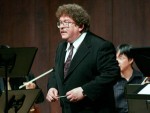Title
The Juilliard School, which supports the growth and interaction of at least three art forms (or more—it depends on how one counts), has established an enduring tradition of cross-disciplinary collaboration. The recent recitals at the School by composer Eric Ewazen, a faculty member since 1980, and poet Lorna Goodison, professor of English at the University of Michigan, attest to the strength of this tradition and vitality of the creative arts in the face of our media-saturated and often indifferent culture.
Work by poet Lorna Goodison (above) featured prominently in a concert given by Eric Ewazen on October 24 in Paul Hall. Goodison was a recent guest speaker at the School.
Composer and faculty member Eric Ewazen (above) presented pieces that were inspired by the poetry of Lorna Goodison.
(Photo by Peter Schaaf)Body
Goodison, who gave a reading on October 22 organized through the Liberal Arts Speaker Series and held in the School’s new Writing and Communication Center, stressed the importance of non-literary art forms to her work. A graduate of the Art Students League, Goodison read a number of selections, including a poem titled “Guernica,” and acknowledged the influence of music in her poetry. “I’m very aware that my voice is informed by hymn,” she said. Goodison has also drawn inspiration from her Jamaican heritage, which features prominently in her poetry—notably in “Counting the Silver,” which she also read at the event—and from such vocal artists as Nina Simone and Sarah Vaughan, about whom she half-joked, “I’m writing because I can’t be them.”
Ewazen, who describes himself as “a big museum-goer,” regularly draws inspiration from the visual arts; he has composed pieces based on the work of artists from Diego Rivera to Ansel Adams. Ewazen also regularly works with the written word. One of the many highlights of his recent recital, held in Paul Hall on October 24 and organized through the Pre-College Division, was Angel of Dreamers, a setting of Goodison’s poetry for baritone, trombone, and string orchestra.
Angel of Dreamers, which draws its name from another Goodison poem, resulted from a commission by Maury Okun, the executive director of the Detroit Chamber Winds and Strings. Okun and David Jackson, a professor of trombone at the University of Michigan, introduced Ewazen to Goodison’s work. “They sent me a book of her poetry and I was captivated immediately because the poetry has strong visual imagery,” Ewazen said in an interview. “I enjoyed [it] so much … I immediately got about six other volumes of her poetry.”
Emotion figures heavily in Ewazen’s works; composing Angel of Dreamers “was happy; it was sad at the same time. Sometimes I’m writing it and tears are going down my cheeks,” he said. In general, Ewazen describes his compositional process as largely dependent on improvisation. “I use the piano when I compose; no Beethoven here—if my hearing goes I have to find a new profession.” At the same time, he noted, “when I start a piece I like to have an idea for what the mood is.”
As in Angel of Dreamers, mood sometimes follows the dictates of a text. The first movement of the work opens with the ardent yet gentle words, “O love, you so fear the dark/ you so accustomed to fighting./ It only seems like the night/ but it’s a veiled overture to light.” Ewazen artfully employs the trombone and string orchestra to reinforce bass soloist’s bittersweet lines in this seeming response to Dylan Thomas’s “Do Not Go Gentle Into That Good Night.”
Two other pieces Ewazen presented, Trio for Horn, Violin, and Piano and Bridgehampton Suite for Flute and Strings, were modeled on works by Brahms and Mozart. However, Ewazen said, “You don’t want to carbon copy the great composers because they have their own voice,” and much of the character in these two pieces reflects the musicians for whom they were composed. Ewazen credits the inspiration for the Bridgehampton Suite to Marya Martin, who participated in its premiere on flute. In Ewazen’s words, the suite, composed for Martin’s Bridgehampton Chamber Music Festival, was “purely Marya Martin’s idea—she herself is so full of energy, and so I wanted to do a piece that reflected her personality.”
Both Ewazen and Goodison, despite their successes, express concern over the treatment of the arts in a culture dominated by popular media. Ewazen, who at the Paul Hall recital gave in-depth introductions to his works, explained, “I tell students now that, yes, they’re going to be performing, but we always have to be conscious of audience outreach because of the competition with all the other media.” Goodison warned against paternalistic treatment of audiences, lamenting the “culture of the dumbing down of people.” No one felt it was necessary, Goodison pointed out, to familiarize her with English culture before exposing her to Shakespeare and Wordsworth.
These concerns notwithstanding, fruitful collaborations such as that between Goodison and Ewazen continue to flourish, strengthening the vitality of the arts. “I always look at times like when Stravinsky composed,” Ewazen said. “There were the great dancers and choreographers of the time, the painters in the period of the Ballets Russes. They were all interacting, learning from each other, and in that age they revolutionized 20th-century art.”






